If you’re looking for the top smart-card readers in 2025 for secure, seamless access, I’ve got you covered. I’ve found versatile options like the Identiv SCR3310v2.0, SCR3500C, and various USB-C readers compatible with Windows, Mac, Linux, and mobile devices. These devices support industry standards like PIV, EMS, and ISO-7816, ensuring security and reliability. Keep exploring, and you’ll uncover the best choices for your specific needs and environments.
Key Takeaways
- Prioritize smart-card readers supporting industry standards like ISO/IEC 7816, CCID, and FIPS for maximum compatibility and security.
- Opt for devices with certified security features such as FIPS compliance and support for PIV and EMS cards.
- Choose models with reliable, high-speed performance for quick authentication in secure environments.
- Consider portable, foldable, or rugged designs suitable for remote work, travel, and military use.
- Ensure compatibility across multiple operating systems including Windows, macOS, Linux, and mobile devices.
SD Card Reader, 4-in-1 USB-C to SD/TF/CF/MS Card Reader with USB-C Adapter
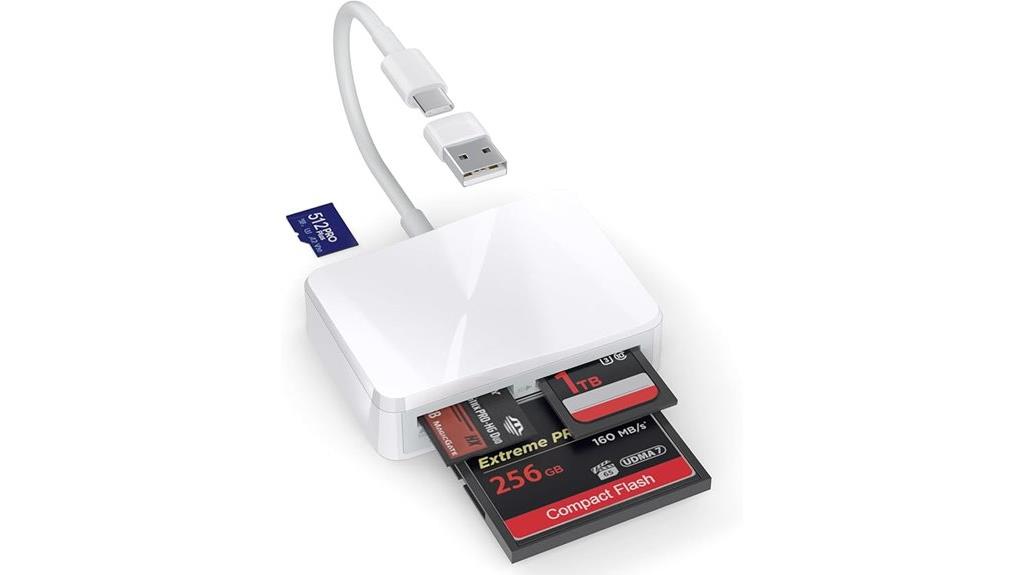
If you’re looking for a versatile and reliable card reader that works seamlessly across devices, the SD Card Reader, 4-in-1 USB-C to SD/TF/CF/MS Card Reader with USB-C Adapter is an excellent choice. It’s compatible with iPhone 16/15, iPad Pro, MacBook Pro/Air, and many Android and Windows devices. With multiple slots for SD, Micro SD, CF, and Memory Stick cards, it supports JPEG, RAW, and HD video formats. Its dual connectors—USB-C and USB-A—ensure compatibility with both new and older gadgets. Plug-and-play design means quick, hassle-free data transfer, making it perfect for on-the-go media management.
Best For: photographers, videographers, and content creators needing quick, reliable data transfer across multiple devices and memory card formats.
Pros:
- Supports a wide range of card formats including SD, Micro SD, CF, and Memory Stick Pro Duo, ensuring versatile compatibility.
- Dual USB-C and USB-A connectors enable seamless use with both modern and older devices.
- Plug-and-play design allows for instant data transfer without the need for drivers or additional software.
Cons:
- Does not support Wi-Fi SD cards, limiting functionality with certain wireless-enabled cards.
- Maximum transfer speeds depend on device and card capabilities, which may vary.
- The compact design, while portable, may be less durable for heavy outdoor use.
USB C to SD Card Reader for iPhone, iPad, Mac, Android
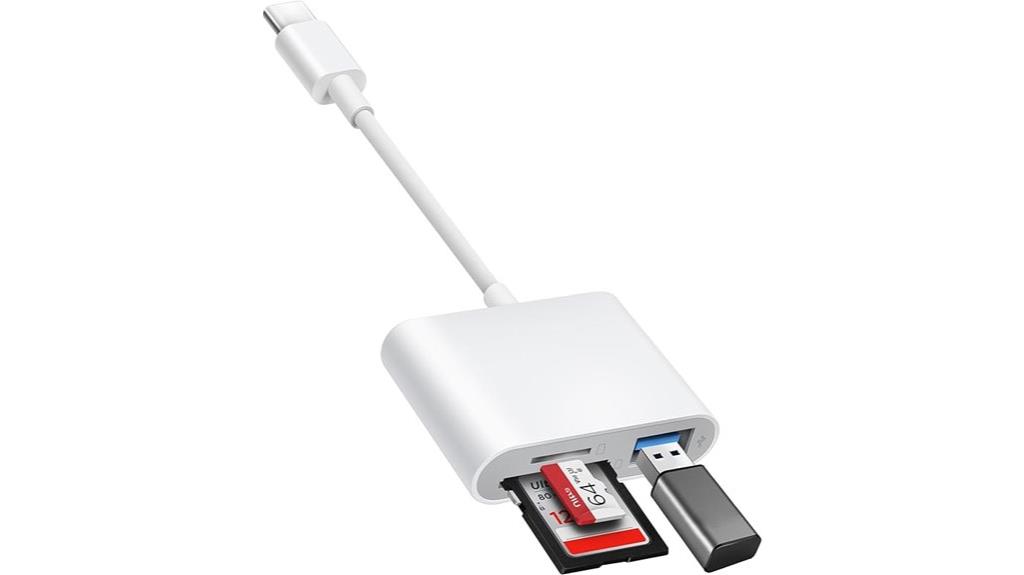
For anyone needing a versatile and reliable way to transfer data between SD cards and their USB-C devices, the USB C to SD Card Reader by BnmxTek stands out. It offers broad compatibility with devices like iPhone 15/16, iPad Pro/Air, MacBooks, Chromebooks, Windows, Linux, and Chrome OS—all without extra drivers. Its dual slots support SD, MicroSD, and high-speed transfers, perfect for 4K videos and large files. The built-in USB-C cable saves space, and an additional USB-A port connects peripherals. Compact, easy to use, and rated highly for speed and reliability, it’s an excellent choice for photographers, videographers, and tech enthusiasts on the go.
Best For: anyone seeking a reliable, versatile SD card reader compatible with a wide range of USB-C devices including smartphones, tablets, laptops, and Chromebooks for quick and easy data transfer without extra drivers.
Pros:
- Universal compatibility with multiple devices and operating systems, including iPhone, iPad, Mac, Android, Windows, Linux, and Chrome OS
- Supports high-speed data transfer for 4K videos, photos, and large files with dual-slot SD and MicroSD support
- Compact, portable design with a built-in USB-C cable and additional USB-A port for peripherals, offering plug-and-play convenience
Cons:
- Does not support Lightning connectors or simultaneous reading of SD and MicroSD cards
- Lacks protective covers for ports, which may expose openings to dust or lint over time
- Not ruggedized, so durability is sufficient for everyday use but may not withstand harsh conditions
Identiv SCR3310v2.0 USB Smart Card Reader
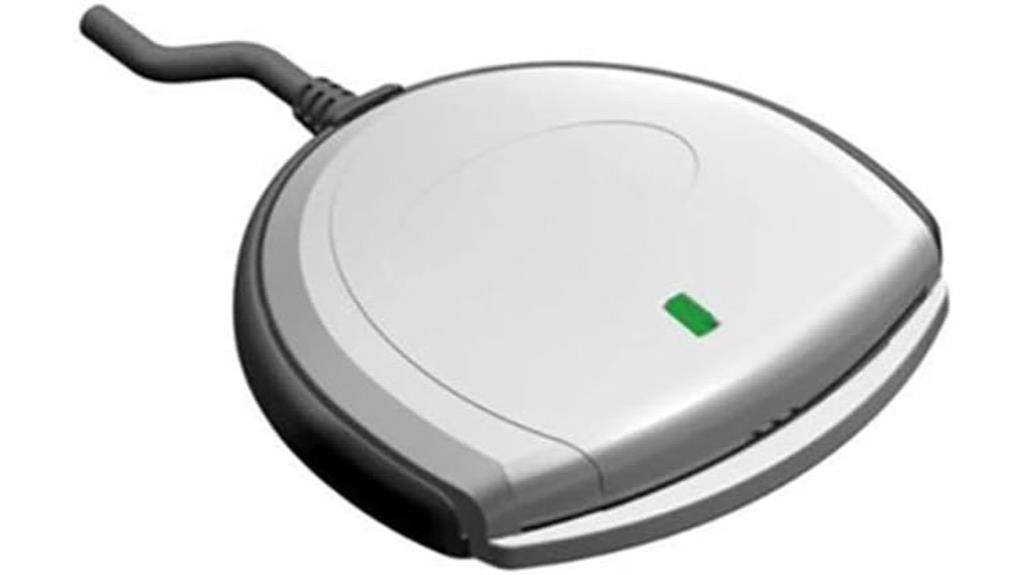
The Identiv SCR3310v2.0 USB Smart Card Reader stands out as an excellent choice for professionals who need reliable, quick, and secure access to contact chip cards. It fully supports industry standards like ISO/IEC 7816, PC/SC, and EMV, ensuring broad compatibility with most contact cards. Its plug-and-play design means it works immediately without extra software, and its fast read/write speed of up to 600 kbps guarantees efficiency. Built for durability and portability, it’s suitable for mobile use and in-field upgrades. With high security certifications, including EMV Level 1 and FIPS 201, it’s ideal for secure identity verification and authentication tasks.
Best For: professionals and organizations seeking a reliable, secure, and portable contact smart card reader compatible with multiple operating systems and industry standards.
Pros:
- Fully supports major industry standards like ISO/IEC 7816, PC/SC, and EMV for broad compatibility
- Plug-and-play design ensures quick setup without additional software or drivers
- Durable, compact, and portable for mobile use and on-the-go applications
Cons:
- Limited cable length may restrict placement options
- May require firmware updates for advanced features or compatibility improvements
- Not designed for contactless cards, limiting use to contact chip cards only
Identiv SCR3500C USB Smartfold Type C
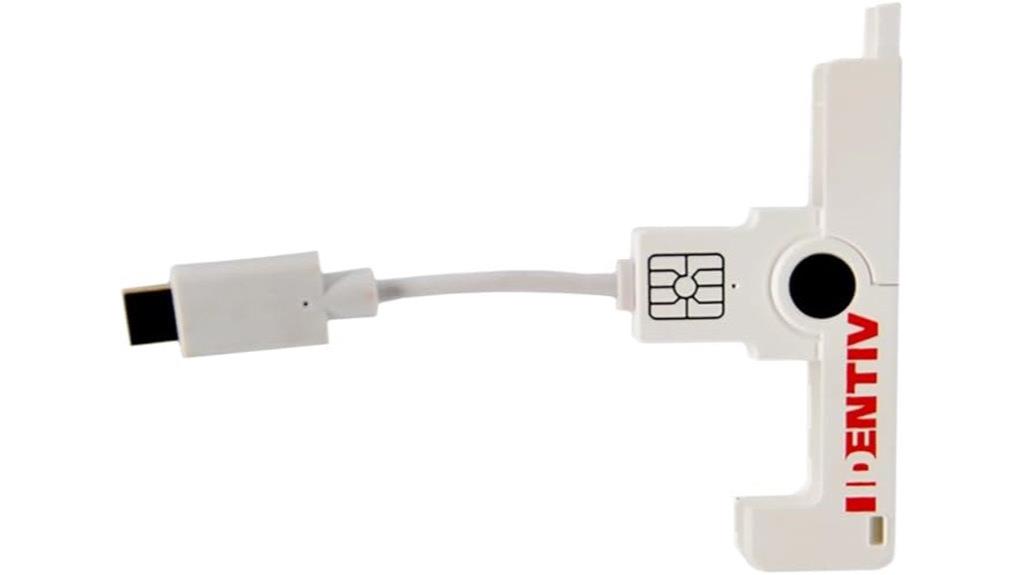
Looking for a smart card reader that combines portability with robust security? The Identiv SCR3500C USB Smartfold Type C is perfect for on-the-go use. Its foldable design makes it incredibly compact, fitting easily in pockets, bags, or keychains. It supports all major smart cards and is compatible with MacBook, phones, and tablets with Type C ports. With full compliance to ISO/IEC 7816, CCID, PC/SC, and FIPS standards, it offers reliable security. Plug-and-play setup guarantees quick, seamless connections, making it ideal for remote work, travel, or everyday access. Despite some durability concerns, it remains a top choice for secure, portable smart card reading.
Best For: users seeking a highly portable, secure smart card reader compatible with MacBook, phones, and tablets, ideal for remote work and travel.
Pros:
- Ultra-compact and foldable design for easy portability
- Supports all major smart cards and complies with security standards like ISO/IEC 7816, FIPS 201, and PC/SC
- Plug-and-play setup ensures quick, seamless connection across devices
Cons:
- Some users report durability issues after prolonged use
- Compatibility with certain phones (e.g., Samsung Note 8) can be inconsistent for login success
- Limited cable length may require adapters or extensions for flexible workspace setups
Identiv SCR3500 Smartfold Smart Card Reader
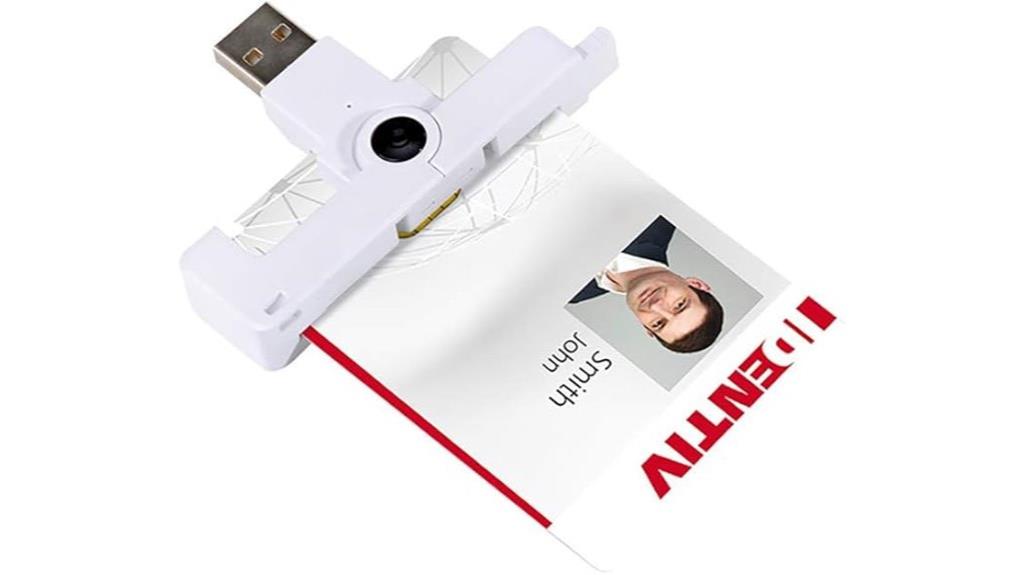
If portability and ease of use are top priorities, the Identiv SCR3500 Smartfold Smart Card Reader stands out as an excellent choice. Its compact, foldable design measures just 6 x 2.4 x 1 inches and weighs only 0.32 ounces, making it perfect for mobile use. It’s plug-and-play on Windows, with broad compatibility for government-issued CAC cards, international IDs, and EU citizen cards. The device supports all major smart card standards, is EMV Level 1 certified, and works seamlessly with Mac OS after minimal setup. Many users praise its reliability, making it an ideal backup or travel-ready smart card reader.
Best For: users seeking a portable, easy-to-use smart card reader for secure identification, government applications, or travel.
Pros:
- Compact, foldable design that easily fits in pockets or on key rings
- Plug-and-play compatibility with Windows and minimal setup for Mac OS
- Broad support for international ID cards, government CACs, and industry standards
Cons:
- The foldable design can block adjacent USB ports on some devices
- Fragility may require careful handling during travel and use
- Some advanced features like certificate management may need additional software
ZOWEETEK CAC Card Reader Military

For military and secure government environments, the ZOWEETEK CAC Card Reader Military stands out due to its advanced support for industry standards like PIV, EMS, and ISO-7816, ensuring reliable and compliant access. Its Realtek chipset delivers robust compatibility with CAC chip cards and applications such as AKO, JKO, and Disa Enterprise Email. The sleek, ergonomic design features a horizontal card slot for easy insertion, and it’s driver-free, plug-and-play, simplifying deployment across Windows, Mac, and Linux systems. Certified CE, FCC, VCCI, and Microsoft WHQL, this reader guarantees security and performance without the need for firmware updates, making it ideal for demanding secure environments.
Best For: professionals in military, government, or secure environments seeking reliable, standards-compliant smart card access with easy plug-and-play setup.
Pros:
- Supports industry standards like PIV, EMS, ISO-7816, and EMV2 2000 Level 1 for broad compatibility and security.
- Certified CE, FCC, VCCI, and Microsoft WHQL, ensuring compliance and safety.
- Driver-free, plug-and-play design simplifies deployment across Windows, Mac, and Linux systems.
Cons:
- Limited to smart card access, not suitable for other types of identification or data transfer.
- May require specific software applications for full functionality, depending on security protocols.
- No firmware updates needed, which could limit future feature enhancements or bug fixes.
ZOWEETEK CAC Reader USB C, CAC Card Reader for Windows, Mac, Linux
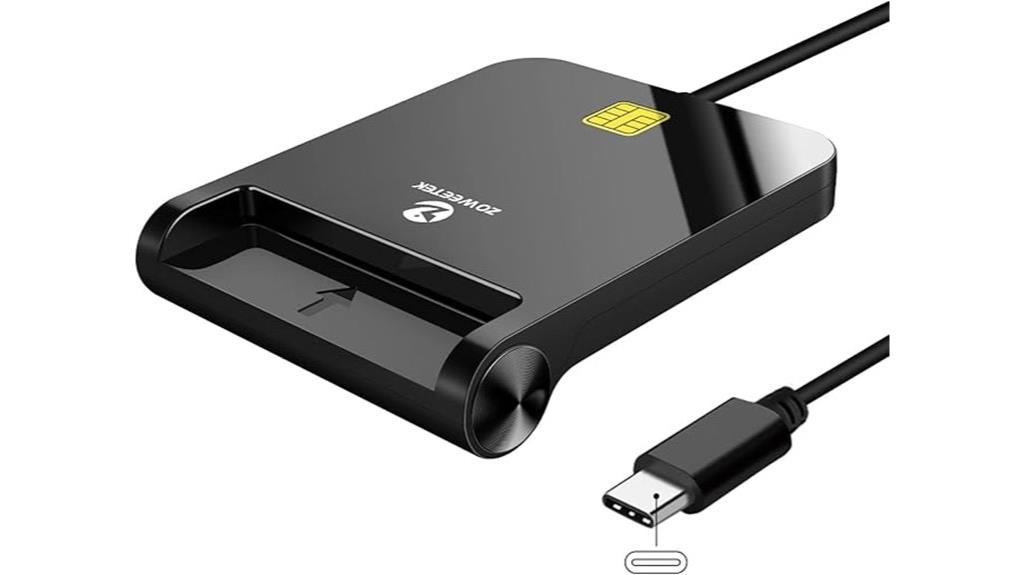
The ZOWEETEK CAC Reader USB-C stands out as an ideal choice for government professionals and security-conscious users who need reliable, cross-platform access to CAC cards. Its military-grade design works seamlessly with Windows 10/11, macOS 10.15+, and Linux, supporting a wide range of government ID and CAC chip cards. The plug-and-play setup requires no extra software, making it easy to use right out of the box. Users praise its fast, consistent performance and sleek, Mac-friendly design. While some note durability concerns, overall, the ZOWEETEK USB-C reader offers dependable, high-speed authentication—perfect for secure access across different operating systems.
Best For: government professionals and security-conscious users seeking reliable, cross-platform CAC card access with fast, secure authentication.
Pros:
- Wide compatibility with Windows, macOS, and Linux systems for versatile use
- Easy plug-and-play setup requiring no additional software installation
- Fast, reliable performance with high-end chips ensuring long service life
Cons:
- Durability concerns due to fragile metal parts that may break over time
- Some units may experience inconsistent functionality needing unplugging and replugging
- Short cable length (~5 cm shorter than ideal) can limit flexibility in setup
SAICOO Smart Card Reader for DOD Military & CAC Cards

Designed specifically for government and military personnel, the SAICOO Smart Card Reader for DOD Military & CAC Cards offers reliable, plug-and-play compatibility with Windows and Mac systems. It supports CAC, PIV, and EMS cards compliant with ISO7816 standards, enabling secure access to military sites and government portals. Its sleek, ergonomic design makes it easy to use on the go, and it’s praised for straightforward setup, especially on Windows. While generally reliable, some users report driver issues and compatibility challenges with Mac, particularly with newer USB-C ports. Overall, it’s a budget-friendly option that delivers solid performance for secure identification and access.
Best For: government and military personnel seeking a reliable, portable CAC card reader compatible with Windows and Mac systems for secure access to military sites and government portals.
Pros:
- Supports multiple card types (CAC, PIV, EMS) compliant with ISO7816 standards, ensuring versatile use.
- Plug-and-play operation on Windows, making setup quick and easy without additional drivers.
- Compact, ergonomic design with positive customer reviews for durability and ease of use on the go.
Cons:
- Compatibility issues and driver concerns, especially with newer MacBook USB-C ports.
- Micro SD card insertion can be unclear and may cause jams or damage if not handled properly.
- Some users experience device malfunctions or slow transfer speeds after extended use or with high-capacity cards.
ZOWEETEK CAC Reader USB C, CAC Card Reader

If you need a reliable CAC card reader compatible with multiple operating systems, the ZOWEETEK CAC Reader USB-C stands out as an excellent choice. It supports Windows 10/11, macOS 10.15 or later, and Linux, ensuring broad compatibility. Designed for US Military and Government DOD ID cards, it offers fast, secure authentication for online banking, government portals, and secure access. The plug-and-play setup means no extra software installation is needed, making it user-friendly, especially for Mac users. While some users note durability issues, most praise its quick, reliable performance and high-end chip quality, making it a solid option for secure identification needs.
Best For: government employees, military personnel, and security-conscious users seeking a reliable, universal CAC card reader compatible with multiple operating systems.
Pros:
- Broad compatibility with Windows, macOS, and Linux systems without additional software
- Fast, reliable performance with high-end chips for secure authentication
- Plug-and-play setup simplifies installation and use
Cons:
- Durability concerns due to fragile metal parts that may break with heavy use
- Some units may experience inconsistent functionality requiring replugging
- Shorter cable length (~5 cm less than ideal) may limit placement options
SmartMedia Card Reader Writer, All-in-1 USB Multi Card Adapter

For professionals and tech enthusiasts who need reliable, high-speed data transfer on the go, the SmartMedia Card Reader Writer, All-in-1 USB Multi Card Adapter stands out as an excellent choice. It supports a wide range of memory cards, including SD, microSD, CompactFlash, Memory Stick, and xD Picture Card. Its slim, pocket-sized design makes it perfect for travel and everyday use. The device is USB-powered, offering plug-and-play convenience with no extra cables or drivers needed. With four card slots operating simultaneously, it ensures fast, stable transfers of photos, music, or files. Its compatibility spans Windows and Mac OS, making it versatile and user-friendly for various media management tasks.
Best For: professionals, photographers, and tech enthusiasts seeking reliable, high-speed data transfer and broad media compatibility on the go.
Pros:
- Supports a wide range of memory cards including SD, microSD, CompactFlash, and Memory Stick formats.
- Compact, pocket-sized design ideal for travel and portable use.
- Plug-and-play operation with no need for extra cables or drivers, ensuring easy and quick setup.
Cons:
- Cannot read 4M, 2M, 1M cards, or 5V cards, limiting some older or specialized media.
- May not support very high-capacity SDXC cards beyond standard specifications.
- USB 2.0 interface, which might be slower compared to newer USB 3.0 or USB-C standards for large data transfers.
AKERU Portable CAC Card Reader for DOD Military Smart Cards

The AKERU Portable CAC Card Reader stands out as an ideal choice for military personnel and government officials needing quick, reliable access to secure systems. It supports CAC, Government ID, and National ID cards, though not credit cards. Compatible with Windows Vista through 10 and macOS 10.4+, it also works with various government platforms like AKO, OWA, and JKO. Its sleek, lightweight design makes it perfect for mobile use, and installation is effortless—plug and play, no drivers needed. Plus, it offers free lifetime technical support and a 12-month warranty, ensuring peace of mind for users who require seamless security access.
Best For: government officials, military personnel, and security professionals who require a reliable, portable smart card reader for secure access to government and enterprise systems.
Pros:
- Supports multiple government and enterprise platforms such as AKO, OWA, and JKO for versatile use
- Plug and play design with no drivers or firmware updates needed for quick setup
- Compact, lightweight, and ergonomically designed for mobile and desktop use
Cons:
- Does not support credit card functionality despite supporting bank cards
- Limited to specific smart card types; not compatible with all RFID or non-ISO7816 cards
- Requires compatible operating systems (Windows Vista/8/8.1/10 and macOS 10.4+) and may not work with outdated systems
CAC Card Reader 2 in 1 USB/Type C Dual Connector
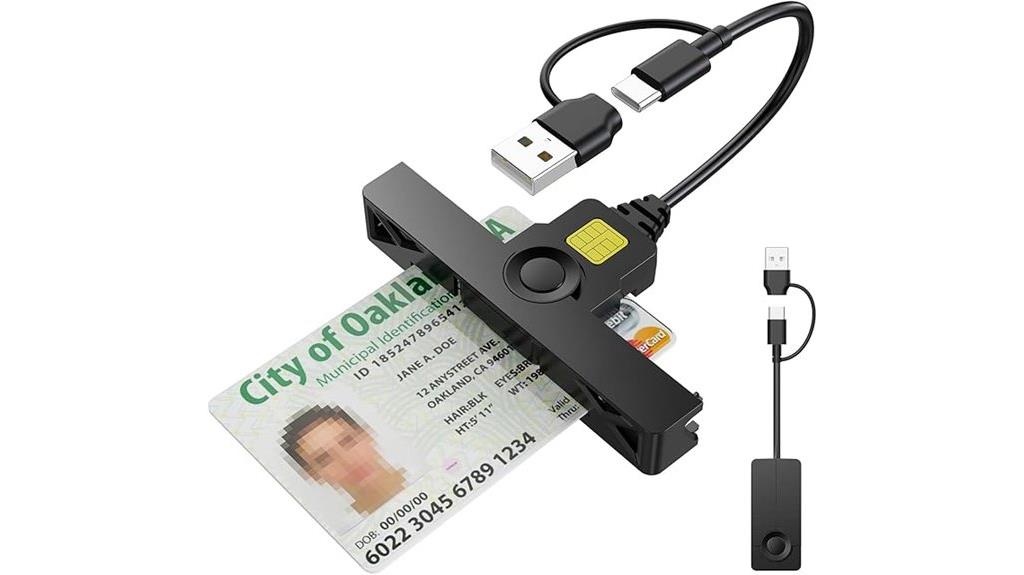
Designed for users who need versatile and reliable connectivity, the CAC Card Reader 2 in 1 USB/Type C Dual Connector offers seamless compatibility with a wide range of smart cards and devices. Its mini fold-and-go design makes it perfect for on-the-move use, supporting CAC cards, government IDs, and various smart cards. It automatically installs drivers on Windows and detects card types, while Mac users just need Java. With high-speed data transfer and robust security features like auto power-off and thermal protection, it it guarantees safe, efficient performance. Plus, its durable, compact design attaches easily to a key ring, making it ideal for military and government professionals.
Best For: professionals in military, government, and security sectors who require reliable, portable smart card reading solutions for secure authentication and data transfer.
Pros:
- Compatible with a wide range of smart cards and devices, including CAC cards and government IDs
- Compact, foldable design with key ring attachment for portability
- Supports high-speed data transfer and advanced security features like auto power-off and thermal protection
Cons:
- Requires third-party CAC Enabler for USG users on Windows
- Mac users need Java installation for proper functionality
- Limited to smart card reading, not suitable for other types of data transfer or storage
CAC Reader Type C, USB C SmartFold CAC Reader

If you need a portable, high-security smart-card reader compatible with multiple operating systems, the CAC Reader Type C, USB C SmartFold CAC Reader is an excellent choice. Its compact, foldable design makes it perfect for travel, and it works seamlessly with Mac OS, Windows, and Linux. Supporting a wide range of cards like military, government, and credit cards, it’s ideal for secure login, online banking, and federal applications. Plug and play with Type C, and it automatically detects your card type. While some users mention fragility, most praise its reliability, ease of use, and portability—making it a top pick for on-the-go security needs.
Best For: users needing a portable, secure, and versatile smart card reader compatible with multiple operating systems for professional and government security applications.
Pros:
- Compact, foldable design ideal for travel and on-the-go use
- Compatible with Mac OS, Windows, and Linux, supporting various secure cards and credentials
- Plug & Play with automatic driver installation on Windows, ensuring quick setup
Cons:
- Some users report fragility of the foldable arms over time
- Initial driver setup may be challenging for Mac users without third-party software
- Limited detailed durability information in reviews
USB C CAC and SIM Card Reader for Mac, Windows, Linux
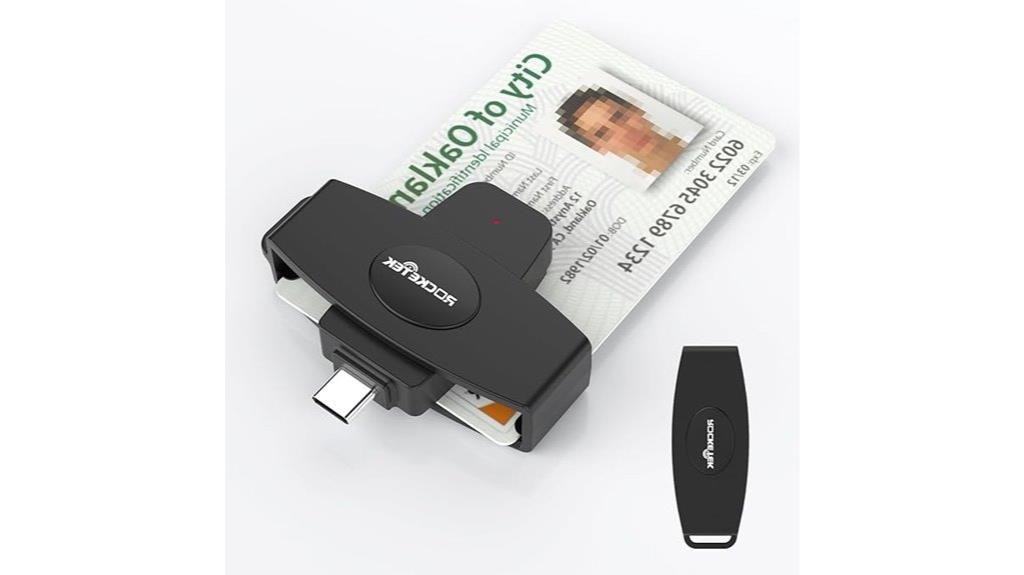
For users needing versatile security solutions across multiple operating systems, the USB C CAC and SIM Card Reader stands out due to its broad compatibility with Mac, Windows, and Linux devices. It supports government ID, military applications, and contact chip cards, making it ideal for secure access. The device is compact, lightweight, and durable, perfect for travel or daily use. It features automatic driver installation on Windows and seamless detection, ensuring quick setup. While its SIM card support is limited to Windows, its secure data transfer and straightforward plug-and-play design make it a reliable choice for professionals and military personnel alike.
Best For: professionals, military personnel, and security-conscious users needing versatile, portable card readers compatible with multiple operating systems.
Pros:
- Broad compatibility with Mac, Windows, and Linux devices, supporting government and military applications.
- Compact, lightweight, and durable design for easy portability and daily use.
- Plug-and-play setup with automatic driver installation on Windows, ensuring quick and hassle-free connectivity.
Cons:
- SIM card functionality is limited to Windows systems, reducing cross-platform versatility.
- Some users report variability in build quality, including potential for physical damage if dropped.
- Occasional incompatibility issues with certain military online portals like JKO due to system updates.
7-in-1 CAC Smart Card Reader for Windows, Linux, MacOS X

The in-1 CAC Smart Card Reader stands out as an ideal choice for users who need versatile, cross-platform security solutions. It supports a wide range of cards, including CAC, government IDs, national IDs, and memory sticks up to 2TB, making it perfect for military, government, and enterprise use. Compatible with Windows XP and later, Mac OS 10.6.2+, and Linux Fedora FC8+, it offers plug-and-play functionality with no driver needed for basic functions. The six independent card slots allow seamless access across devices, while the durable, lightweight design ensures portability. Overall, it’s a reliable, multifunctional tool that simplifies secure data transfer across platforms.
Best For: professionals in military, government, and enterprise sectors needing versatile, cross-platform smart card access and secure data transfer.
Pros:
- Supports a wide range of card types including CAC, ID, SD, and memory sticks up to 2TB.
- Compatible with Windows, MacOS, and Linux, offering seamless cross-platform functionality.
- Plug-and-play design with no driver required for basic use, plus durable and portable construction.
Cons:
- Requires additional drivers or software from card providers for specific banking or ID card functionalities.
- Slots operate independently, not simultaneously, which may limit certain multi-card operations.
- Some features depend on country or bank-specific software, requiring extra setup steps.
Factors to Consider When Choosing Smart‑Card Readers
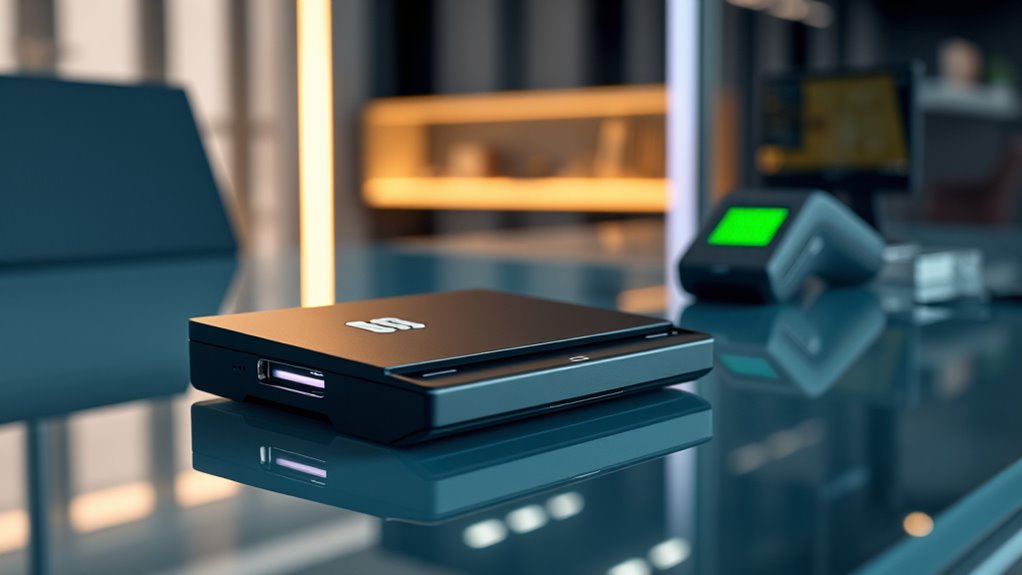
When selecting a smart-card reader, I consider factors like compatibility with my devices and the types of cards it supports to guarantee seamless integration. I also look at connection options, build quality, and security certifications to keep my data safe. These points help me choose a reliable, future-proof device that meets my security needs.
Compatibility With Devices
Choosing a smart-card reader that’s compatible with your device is essential for smooth operation. First, check your device’s port—whether it’s USB-A, USB-C, or Thunderbolt—and guarantee the reader matches. Next, verify that the reader supports your operating system, like Windows, macOS, Linux, or Android, to avoid compatibility issues. Also, consider whether it’s plug-and-play or needs additional drivers or software, as this affects setup time and ease of use. make certain the card types supported, such as CAC, PIV, or memory cards, align with your needs for proper functionality. Lastly, confirm that the device supports your power and connectivity standards to prevent operational hiccups. Ensuring these compatibility factors helps you select a reader that integrates seamlessly with your system.
Supported Card Types
Are you certain the smart-card reader you’re considering supports the specific card types you need? It’s essential to verify compatibility with your cards, whether they’re CAC, PIV, MIFARE, or M2. Make sure the reader supports multiple formats like ISO/IEC 7816 or ISO/IEC 14443, depending on your application. If you require multimedia or storage access, check for support of SD, Micro SD, or Memory Stick standards. Additionally, confirm that the device can handle different voltage levels—such as 5V, 3V, or 1.8V—to guarantee it works with various card specifications. Finally, consider if it supports both government and commercial cards, contact and contactless types, for maximum versatility in your security setup.
Port and Connection Options
Selecting the right port and connection options for your smart-card reader is essential to guarantee seamless integration with your devices. The port type—such as USB-C, USB-A, or micro-USB—affects compatibility with your existing hardware. Some readers feature dual or multi-connection options, offering versatility across different devices. The connection interface also impacts data transfer speeds; newer standards like USB 3.0 and USB 3.1 deliver faster performance than older versions. Port location and accessibility are important factors, especially if you have limited space or multiple peripherals. Additionally, the physical design, such as foldable or compact connectors, can enhance portability and ease of use. Ensuring these factors align with your setup helps create a smoother, more efficient security process.
Durability and Build Quality
When it comes to smart-card readers, durability and build quality directly impact their longevity and reliability. I look for devices made from reinforced plastics or metal components, as these materials can withstand daily wear and tear. A well-designed reader features secure port connections and sturdy folding arms or covers, preventing breakage during frequent use or travel. Reinforced internal parts and shock-resistant features also matter, reducing the risk of malfunctions over time. User reviews often highlight issues like loose ports, fragile hinges, or thin metal parts, emphasizing the importance of quality manufacturing. Additionally, choosing a device with industry certifications like CE or FCC signals adherence to manufacturing standards, giving me confidence in its durability and long-term performance.
Security and Certification
Ensuring your smart-card reader meets industry security standards is crucial for safeguarding sensitive data during transactions. I recommend checking for compliance with key standards like ISO/IEC 7816, PC/SC, and CCID, which ensure secure data transmission. Certifications such as EMV Level 1, FIPS 201, and GSA FIPS 201 indicate the device adheres to strict security protocols, especially for government and financial use. It’s also essential to verify support for secure authentication methods, including digital signing, encryption, and secure login features, to protect against unauthorized access. Additionally, look for devices that have undergone certification from recognized authorities, confirming they meet national and international security requirements. Firmware and hardware security features like tamper resistance, secure key storage, and firmware upgrade capabilities help maintain long-term security integrity.
Frequently Asked Questions
How Do Smart-Card Readers Protect Against Data Breaches?
Smart-card readers protect against data breaches by using encryption and secure authentication methods. When I use one, it verifies my identity with a unique chip, making it difficult for hackers to access sensitive information. They also require physical contact or close proximity, adding an extra layer of security. This guarantees that only authorized users can access data, considerably reducing the risk of breaches and keeping my information safe.
Are There Compatibility Issues With Older Device Models?
Back in the day, using a rotary phone, compatibility issues with older device models can still pop up with smart-card readers today. I’ve found that many modern readers are designed for universal compatibility, but some older devices might need adapters or firmware updates. It’s always wise to double-check the specifications before purchasing. That way, you avoid surprises and guarantee seamless integration with your existing hardware.
What Is the Average Lifespan of a Smart-Card Reader?
The average lifespan of a smart-card reader is around 5 to 7 years, depending on usage and build quality. I’ve found that regular maintenance and careful handling can extend its life. Modern devices tend to last longer thanks to better materials and technology. If you want to maximize your investment, look for reputable brands and keep the device clean and protected from environmental damage.
How Do Firmware Updates Enhance Security Features?
Did you know that firmware updates can improve security by up to 50%? I find that fascinating! They enhance security features by patching vulnerabilities, fixing bugs, and adding new encryption methods. When I update my smart-card reader’s firmware, I guarantee it stays protected against the latest threats. It’s like giving my device a security boost, making it harder for hackers to exploit weaknesses and keeping my data safe.
Can Smart-Card Readers Be Used for Multi-Factor Authentication?
Yes, smart-card readers can definitely be used for multi-factor authentication. I find that combining a smart card with a PIN or biometric verification considerably boosts security. This layered approach ensures that even if someone manages to steal the card, they still need the additional authentication factor. I recommend using smart-card readers that support multiple authentication methods for the most secure and seamless experience.
Conclusion
Choosing the right smart-card reader feels like finding the perfect key for a complex lock—I’ve been there, fumbling through options until I found one that fits seamlessly. With the right device, my security feels as solid as a vault door, safeguarding my digital world. Remember, the best smart-card reader isn’t just about features; it’s about trust and reliability—like a trusty companion that never lets you down in critical moments.









